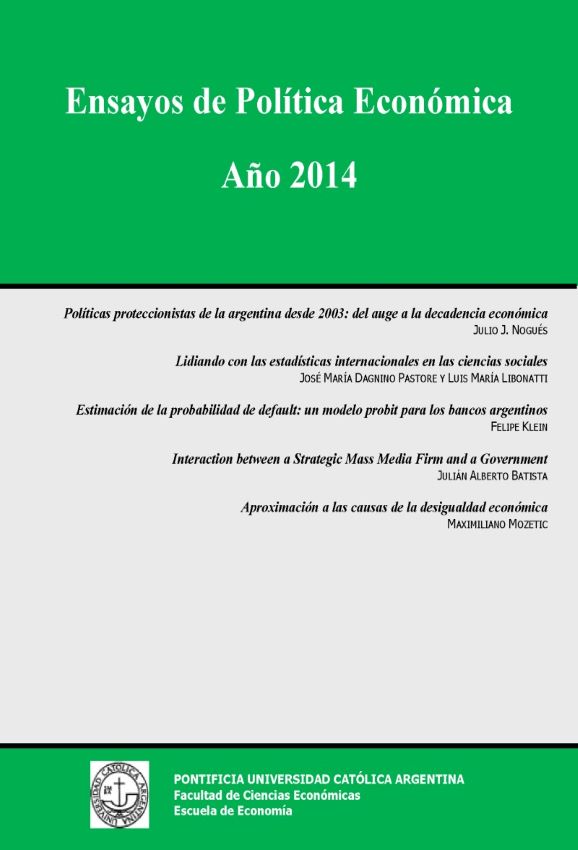La relación virtuosa de la seguridad y la inversión extranjera directa en Colombia (1994 – 2013)
Palabras clave:
Violencia, inversión extranjera directa, Índice de criminalidad, ColombiaResumen
Este artículo considera el PIB, la inversión extranjera directa y el crimen en Colombia, entre
1994 y 2013, para explorar relaciones que se pueden presentar entre ellas, teniendo en cuenta un índice de criminalidad, que agrupa delitos de alto impacto. La hipótesis es que las mejores condiciones de seguridad en el país durante la década anterior, que se evidencia con la reducción del índice de criminalidad, favorecieron el incremento en la inversión extranjera, lo que posibilita finalmente un mayor desarrollo económico y social en el largo plazo. Para contrastar la hipótesis, se utiliza un modelo ARIMA-ARCH que recoge la volatilidad y la inercia de las variables, encontrando una relación inversa entre el crimen y la inversión extranjera; una relación directa entre la inversión extranjera y el producto; y una relación inversa entre el indicador de crimen y el producto del país.
Descargas
Citas
Acemoglu, D., Robinson, J. A., & Woren, D. (2012). Why nations fail: the origins of power, prosperity and poverty (Vol. 4). New York: Crown Business.
Aguiar, S., Aguiar-Conraria, L., Gulamhussen, M. A., & Magalhães, P. C. (2012). Foreign direct investment and home-country political risk: the case of Brazil. Latin American Research Review, 47(2), pp. 144-165.
Aizenman, J., & Glick, R. (2003). Military expenditure, threats, and growth (No. w9618). National Bureau of Economic Research.
Álvarez, S., & Rettberg, A. (2008). Cuantificando los efectos económicos del conflicto: una exploración de los costos y los estudios sobre los costos del conflicto armado colombiano. Colombia Internacional, (67), pp. 14-37.
Ashby, N. J., & Ramos, M. A. (2013). Foreign direct investment and industry response to organized crime: The Mexican case. European Journal of Political Economy, pp. 30, 80-91.
Ayres, R. L. (1998) Crime and violence as development issues in Latin America and the Caribbean. World Bank Publications.
Bosworth, B., & Collins, S. M. (2003) The empirics of growth: An update. Brookings papers on economic activity, 2003(2), 113-206.
CEPAL (20019. A. E. D. A. L. Una década de luces y sombras: América Latina y el Caribe en los años noventa. CEPAL, Bogotá.
Coinvertir y Departamento Nacional de Planeación (2000). Obstáculos y oportunidades para la inversión extranjera en Colombia. Bogotá.
Correa-Cabrera, G. (2013). Desarrollo Empresarial, Inversión Extranjera y Crimen Organizado en México: Los Efectos Reales de la Violencia.
Daniele, V., & Marani, U. (2011). Organized crime, the quality of local institutions and FDI in Italy: A panel data analysis. European Journal of Political Economy, 27(1), pp. 132-142.
Detotto, C., & Otranto, E. (2010). Does crime affect economic growth?. Kyklos, 63(3), pp. 330-345.
De Mello, J. M., & Zilberman, E. (2008). Does crime affect economic decisions? An empirical investigation of savings in a high-crime environment. The BE Journal of Economic Analysis & Policy, 8(1).
Di Tella, R., Edwards, S., & Schargrodsky, E. (Eds.) (2010). The economics of crime: lessons for and from Latin America. University of Chicago Press.
Echeverry, J. C., Salazar, N., & Navas, V. (2001). El conflicto colombiano en el contexto internacional, Martínez, A.(Editora), Economía, Crimen y Conflicto. Universidad Nacional: Bogotá, pp. 77-128.
Gutiérrez, F. (2014). El orangután con sacoleva: cien años de democracia y represión en Colombia (1910- 2010). Bogotá: Ed. Debate.
Kaufmann, D., Kraay, A., & Mastruzzi, M. (2009). Governance matters VIII: aggregate and individual governance indicators, 1996-2008. World bank policy research working paper, (4978).
Londoño, J. L., & Guerrero, R. (2000) Violencia en América Latina: epidemiología y costos. Asalto al desarrollo. Violencia en América Latina.
Lucas, R. E. (1990). Why doesn’t capital flow from rich to poor countries?. The American Economic Review, pp. 92-96.
Lucas, R. E. (1998). On the mechanics of economic development. ECONOMETRIC SOCIETY MONO- GRAPHS, pp. 29, 61-70.
Maertens, F., & Anstey, C. (2007). Crime, violence, and development: Trends, costs, and policy options in the Caribbean. Caribbean: United Nations Office on Drugs and Crime Latin America and the Caribbean Region of the World Bank.
Mauro, P. (1995). Corruption and growth. The quarterly journal of economics, pp. 681-712.
Ministerio de Defensa Nacional & Departamento Nacional de Planeación. (2009). Metodología para el cálculo del gasto en defensa y seguridad. Imprenta Nacional de Colombia.
Mundial, B. (2007). Crime, violence, and development: trends, costs, and policy options in the Caribbean. In Crime, violence, and development: trends, costs, and policy options in the Caribbean. ONU.
North, D. C. (1990). Institutions, institutional change and economic performance. Cambridge university press.
O’Connor, E. (2011). El debate de la política económica y la crisis global. Programa de Análisis de Coyuntura Económica-PAC Informe Económico. Número 6.
Pan, M., Widner, B., & Enomoto, C. E. (2012). Growth and crime in contiguous States of México. Review of Urban & Regional Development Studies, 24(1-2), pp. 51-64.
Parra, C. (1998). Determinantes de la inversión en Colombia: evidencia sobre el capital humano y la violencia. Archivos de macroeconomía, (84).
Quintero, D. M., Lahuerta, Y., & Moreno, J. M. (2008). Un índice de criminalidad para Colombia. Revista Criminalidad, (50), pp. 37-58.
Suarez, G., & Pshisva, R. (2006). “Captive Markets”: The Impact of Kidnappings on Corporate Investment in Colombia. FEDS Working Paper No. 2006-18.
Descargas
Publicado
Cómo citar
Número
Sección
Licencia








